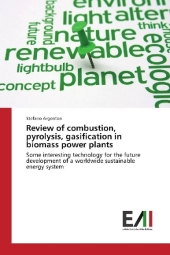 Neuerscheinungen 2017Stand: 2020-02-01 |
Schnellsuche
ISBN/Stichwort/Autor
|
Herderstraße 10
10625 Berlin
Tel.: 030 315 714 16
Fax 030 315 714 14
info@buchspektrum.de |

Stefano Argenton
Review of combustion, pyrolysis, gasification in biomass power plants
Some interesting technology for the future development of a worldwide sustainable energy system
2017. 228 S. 220 mm
Verlag/Jahr: EDIZIONI ACCADEMICHE ITALIANE 2017
ISBN: 6-202-44901-2 (6202449012)
Neue ISBN: 978-6-202-44901-4 (9786202449014)
Preis und Lieferzeit: Bitte klicken
This review exposes the combustion systems, gasification and pyrolysis of biomass in the main aspects related to the development and current state of art. Biomass gasification is an interesting technology in the future development of a worldwide sustainable energy system, which can help to decrease our current dependence on fossil fuels. Biomass gasification is a thermal process where solid fuel is converted into a useful gas using several gasifying agents such as air, and steam. The producer gas has a great number of applications. The most important is being combustion for power and heat generation as well as raw gas for production of fuels or chemicals. These technologies have historically been based upon partial oxidation or partial combustion principles, resulting in the production of a hot, dirty, low calorific value gas that must be directly ducted into boilers or dryers. In addition to limiting applications and often compounding environmental problems, these technologies are an inefficient source of usable energy. Biomass gasification is the latest generation of biomass energy conversion processes aimed to increase the efficiency.
M.Eng. Stefano Argenton (26/12/1982). He holds a Master of Science in Mechanical Engineering at the University of Ferrara. From early 2014 he first worked in technical office and into ICI lab H2-Heat as senior project engineer. He is involved in design and development of CHP systems, steam boilers and heat generators using both CFD and FEA analysis


